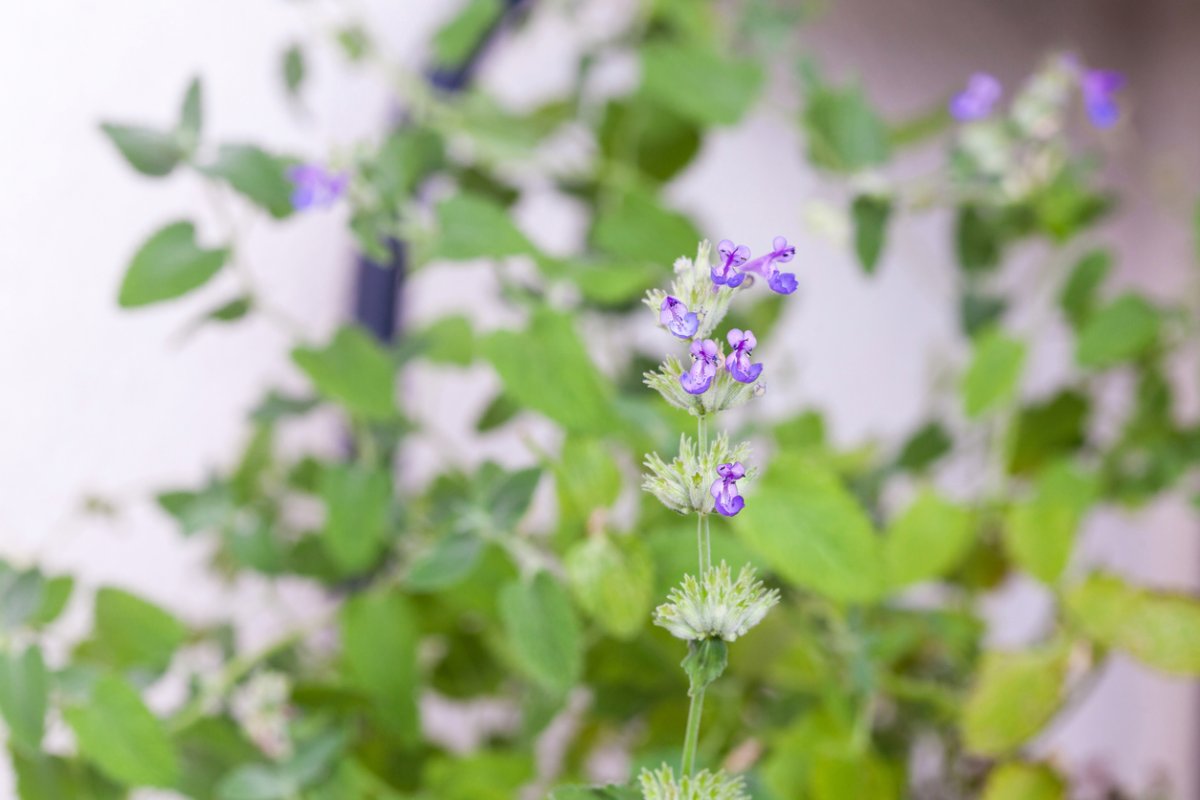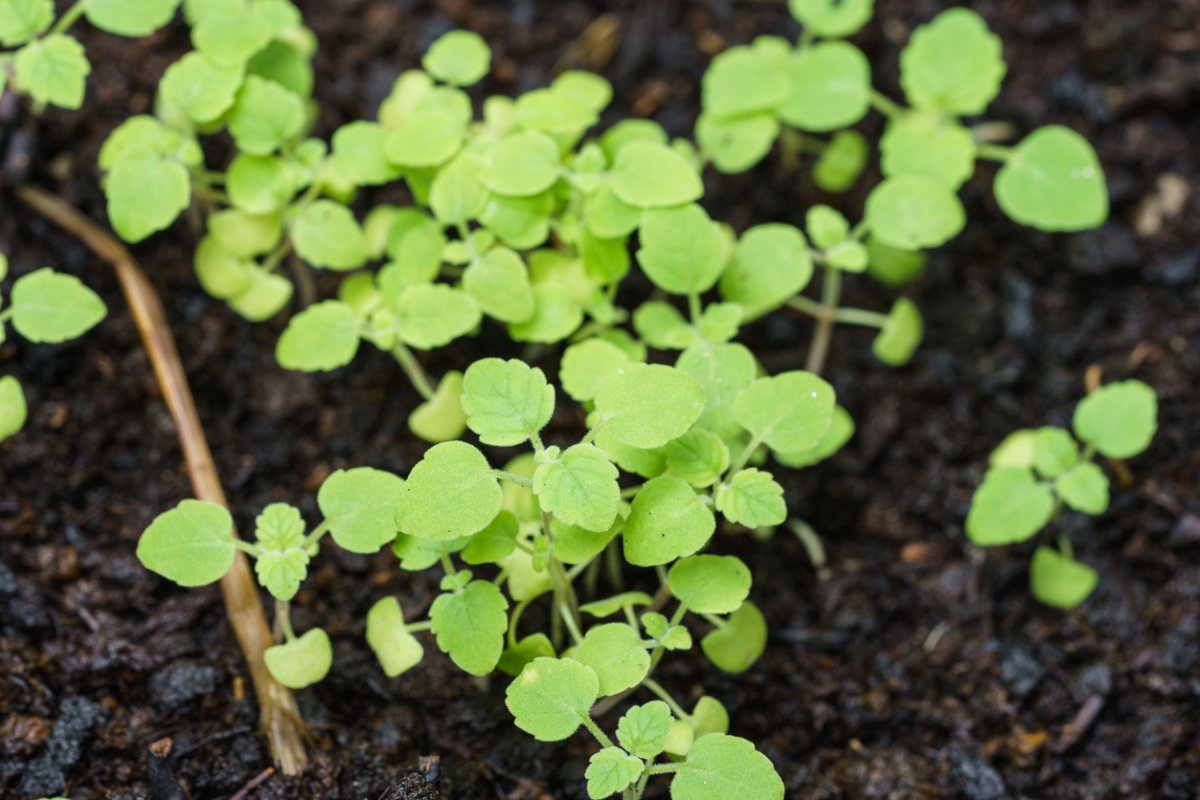

We may earn revenue from the products available on this page and participate in affiliate programs. Learn More ›
A perennial herb sometimes used in medicinal teas, catnip plant is most well known for the intoxicating effect it has on cats. “The smell can trigger strange behavior patterns. Some of these behaviors include licking, chewing, head shaking, chin and cheek rubbing, rolling, and salivation,” notes Jeff Schalau of the University of Arizona Cooperative Extension.
However, only about two-thirds of adult cats have any reaction to the herb. (Kittens don’t.) When considering how to grow catnip, keep in mind that the plant’s chemical composition resembles cat pheromones, and fascinated felines may end up damaging your catnip plant.
Growing Catnip at a Glance
Common Name: Catnip
Scientific Name: Nepeta cataria
Hardiness Zone: 3 to 9
Soil: Light, well-drained
Light: Full sun to partial shade
Water: Moderate
Food: Low-nitrogen organic fertilizer
Propagation: Seeds
Safety: Nontoxic in moderate amounts

Catnip Characteristics
A member of the mint family, a full-grown catnip plant reaches 3 feet tall and has square stems and toothed, triangular leaves up to 3 inches long. A single catnip flower is ¼ to ½ inch in size. These two-lipped flowers are white with pink or purple spots, and blooms are produced on a whorled 1- to 6-inch spike with other blooms in late spring and early summer.
According to Missouri Botanical Garden, “Catnip leaves have been used for making an herbal tea that reportedly helps reduce anxiety, induce sleep, promote perspiration, soothe sore throats, and comfort upset stomachs.”
Fresh catnip can also be used as an herb for cooking. Chopped catnip leaves make great additions to soups, sauces, pasta, and vegetables.
Additionally, catnip plants are beneficial for your garden. The herb repels harmful insects such as aphids and squash bugs that can damage your crops.
Self-sowing heavily enough to be invasive, the herb has naturalized throughout much of the U.S. So if you already have wild catnip, you won’t need to plant it.
Recommended Catnip Varieties
Most Nepeta cultivars are of species other than cataria, but there are a couple of true catnip cultivars.
- Nepeta cataria ‘Citriodora’: This lemon-scented catnip variety grows to 2 feet with purple-dotted white flowers, but it isn’t attractive to cats who don’t favor citrus flavors or fragrances.
- Nepeta cataria ‘CR9’: This cultivar was developed specifically for commercial agriculture production in North America and has a more upright growth pattern, higher biomass, and more essential oil.

Planting Catnip
Because the herb tends to get mangled by cats, when planting catnip, you may want to choose a location out of their reach, such as a hanging basket. Alternatively, cover the plant with an upside-down wire basket or bottomless bird cage to prevent them from getting to it.
When is the best time to plant catnip?
Start catnip from seeds indoors under a grow light 1 to 2 months before your last spring frost. Once the catnip seedlings have reached 2 to 3 inches in height, you can harden them off and transplant them into the ground outdoors in late spring after all chance of frost has passed.
Where can catnip grow?
In the North, choose a location in full sun with well-drained soil that has a pH near 6.6. In the South, opt for a position that receives sun in the morning and some shade during the afternoon.
How do you plant catnip?
Plant catnip near where you sit outdoors to help repel mosquitoes, deter ants, and perhaps reduce the need for bug sprays.
- Remove your catnip plant from its container.
- Dig a hole large enough for its root ball.
- Set the plant in the hole at the same height it grew in its container and backfill the soil around the roots.
- If you have more than one plant, space them at least 18 inches apart.
Can you grow catnip in containers?
If you have no room to grow catnip in your garden or if you want to keep your plant out of reach of prowling neighborhood felines, you can plant it in a hanging basket that is at least 10 inches deep. Keep it pinched back since it’s typically too tall and gangly to make a good basket plant. The height of catnip makes growing catnip indoors in a pot less than ideal.

Watering Catnip
The University of Minnesota Extension advises that you water in-ground herbs such as catnip “once a week by soaking the soil to a depth of 8 inches, to ensure that the root zone is receiving enough moisture.”
It also notes that container plants may need watering as often as once per day during summer to prevent their wilting but warns that soggy conditions can cause root rot. For that reason, make sure those containers have drainage holes and are filled with a fast-draining soil.
Fertilizing Catnip Plants
The University of Minnesota Extension also warns against overfertilizing herbs as “rich soils may hurt the herb’s quality by promoting rapid, lush growth that will contain only small amounts of the essential oils that give herbs their characteristic aromas and flavors.”
For in-ground herbs, apply a 5-10-5 organic fertilizer once per year in spring at the rate of 1/8 cup per plant, scratching it into the soil around the plant and watering it in. For container plants, choose a low-nitrogen liquid organic fertilizer such as 2-4-1, but apply it at only half the recommended rate once per month during the growing season.

Pruning Catnip
When growing catnip, which is a naturally gangly plant, pinch it back early to encourage it to branch out. Once your seedlings are 3 to 4 inches tall and have a few leaves, pinch or snip off the topmost pair of leaves on each one to force it to produce side shoots. Then, when harvesting your catnip after it blooms, cut it back to within 3 to 4 inches of the ground to encourage it to come back thickly.
Propagating Catnip
You will get better germination from catnip seeds by freezing them twice before you sow them. To do that, simply place them inside a zip-top bag in your freezer for a month, allow them to thaw overnight, then place them back in the freezer again for another month.
Afterward, place them in warm water to thaw before you press them into the surface of damp and sterile seed-starting mix without covering them. Keep that mix at 70 to 80 degrees Fahrenheit and you should see catnip sprouts in 10 to 20 days.
Safety Considerations
Although catnip is generally safe for both humans and their pets, the ASPCA warns that “it can cause vomiting and diarrhea” and that “it makes some cats sedated and others stimulated.”
According to WebMD, “Catnip is possibly safe for most adults when taken by mouth in small amounts,” but it does note that it can cause headaches and vomiting if it’s taken in excessive amounts, such as if one were to drink several cups of catnip tea.

Potential Pests and Diseases
Due to its insect-repelling qualities, catnip generally isn’t bothered by pests—unless you count stray cats.
Catnip may occasionally contract powdery mildew, which looks like white powder on the foliage. This mildew is especially likely to appear when the weather is rain-free but humid with cool nights. To prevent mildew, make sure your plants receive plenty of sun and are well spaced to allow air circulation around them. Also, avoid overfertilizing when catnip is growing, as that can cause too much new growth that’s susceptible to mildew.
Harvesting Catnip
Because catnip grows quickly, you may be able to harvest more than once a year.
When is the best time to harvest catnip?
Although herbs are usually cut just before they bloom, some sources recommend harvesting catnip when it is in full bloom, as its flowers and leaves are the most strongly scented parts of the plant. Flowering generally begins in early summer for plants more than a year old. Just-started seedlings may bloom later.
How do you harvest catnip?
Because catnip flowers attract bees and wasps as well as butterflies, be careful where you grasp the stems while cutting them.
- Harvest your catnip in mid-morning on a dry day.
- Use pruning shears to cut each plant off about 3 to 4 inches above the ground.
- String the plants upside down in a dry, well-ventilated location to dry.
How do you store catnip?
Once your plants have dried completely, strip off the catnip leaves and flowers and keep those, while discarding the stems. Store the dried leaves and blooms in airtight containers such as capped glass jars or zip-top bags in a dim, cool location for up to a year. If moisture forms on the insides of the containers, this means the herb wasn’t dry enough when you stored it.

Preparing Catnip Plants for Winter
When Jack Frost begins nipping at your catnip in autumn, your catnip plant will die back to the ground. That is natural and nothing to be alarmed about. Unless your catnip is growing in soggy ground where water may freeze around its roots, it should survive the winter easily enough.
Hardy in USDA Zones 3 through 9, it may not have nine lives as its admirers do, but it is a tough plant. However, you may want to mulch perennial herbs with 2 or 3 inches or more of straw or dead leaves to provide some protection from drastic temperature variations.
Looking for more beginner-friendly herbs? Check out our guides on growing basil and mint.
